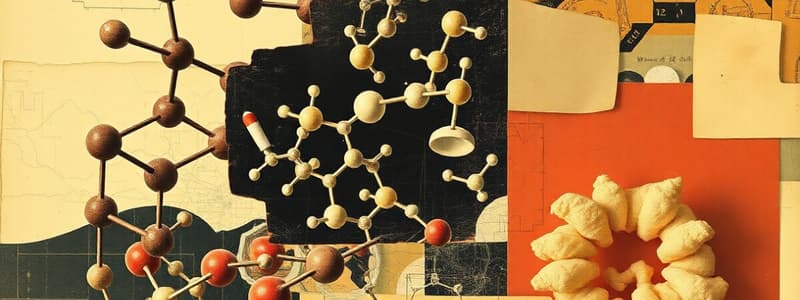Podcast
Questions and Answers
What is the primary function of glycogen in animals?
What is the primary function of glycogen in animals?
- Energy storage (correct)
- Transport of nutrients
- Structural support
- Insulation
Which of the following is a characteristic of saturated fats?
Which of the following is a characteristic of saturated fats?
- They consist only of single bonds. (correct)
- They have a high water solubility.
- They contain one or more double bonds.
- They are usually liquid at room temperature.
What distinguishes phospholipids from triglycerides?
What distinguishes phospholipids from triglycerides?
- Triglycerides lack a glycerol backbone.
- Phospholipids have a phosphate group attached. (correct)
- Triglycerides contain hydrophilic regions.
- Phospholipids contain only saturated fatty acids.
What is the general structure of steroids?
What is the general structure of steroids?
What role do lipids play aside from energy storage?
What role do lipids play aside from energy storage?
Why are unsaturated fats typically liquid at room temperature?
Why are unsaturated fats typically liquid at room temperature?
What is a common form of steroid that aids in various biological processes?
What is a common form of steroid that aids in various biological processes?
Which polysaccharide provides structural support in plants?
Which polysaccharide provides structural support in plants?
What defines a monosaccharide?
What defines a monosaccharide?
Which of the following is a disaccharide?
Which of the following is a disaccharide?
How are polysaccharides characterized in terms of sugar units?
How are polysaccharides characterized in terms of sugar units?
What is the primary role of carbohydrates in living organisms?
What is the primary role of carbohydrates in living organisms?
Which of the following correctly describes dehydration synthesis in the formation of disaccharides?
Which of the following correctly describes dehydration synthesis in the formation of disaccharides?
Which type of carbohydrate is primarily stored in plants for energy?
Which type of carbohydrate is primarily stored in plants for energy?
What distinguishes aldoses from ketoses?
What distinguishes aldoses from ketoses?
Which of the following is NOT a characteristic of polysaccharides?
Which of the following is NOT a characteristic of polysaccharides?
Flashcards are hidden until you start studying
Study Notes
Biomolecules
- Also referred to as organic molecules.
- Act as fuel powering an organism’s metabolism.
- Essential molecules that constitute living organisms.
- Four main types: carbohydrates, lipids, proteins, and nucleic acids.
Carbohydrates
- Most abundant biomolecules.
- Composed of carbon, hydrogen, and oxygen.
- Found in various forms, including sugars and starches.
- Provide energy, crucial for brain and muscle function.
- Classified into three types: monosaccharides, disaccharides, and polysaccharides.
Monosaccharides
- Also called simple sugars.
- The basic building blocks (monomers) of complex carbohydrates.
- Classified as aldoses and ketoses:
- Aldoses: Possess an aldehyde group (-CHO) at the molecule's end.
- Ketoses: Have a ketone group (C=O) on the second carbon atom.
- Further classified based on the number of carbon atoms:
- Dioses: Two carbon atoms.
- Trioses: Three carbon atoms.
- Pentoses: Five carbon atoms (e.g., ribose, a component of RNA).
- Ribose plays a role in genetic information.
- Hexoses: Six carbon atoms (e.g., glucose and fructose).
- Glucose: Major energy source for most organisms.
- Fructose: Found in numerous plants.
Disaccharides
- Formed when two monosaccharides join through a condensation reaction:
- Dehydration synthesis: Water is removed during the joining process.
- Glycosidic Bond: The bond formed between the two monosaccharides.
- Examples:
- Sucrose (Table Sugar): Glucose + Fructose.
- Lactose (Milk Sugar): Glucose + Galactose.
- Maltose (Malt or Beer Sugar): Two glucose molecules.
- The least sweet amongst the disaccharides.
- Common sweetener used today.
Polysaccharides
- Composed of three or more monosaccharides.
- Not sweet.
- Do not crystallize when dehydrated.
- Two molecular structures:
- Linear Polysaccharides: Rigid structure, insoluble in water.
- Branched Polysaccharides: Soluble in water.
- Used for energy storage:
- Starch: Glucose chains, energy storage in plants.
- Glycogen: Glucose chains, energy storage in animals.
- Pectin: A soluble fiber, a type of polysaccharide.
- Some polysaccharides provide structural support:
- Cellulose: Found in plant cell walls, a structural polysaccharide.
- Chitin: Found in fungi cell walls and exoskeletons of animals like crustaceans.
Lipids
- Biomolecules containing chains of hydrocarbons.
- Hydrocarbons are made up of carbon and hydrogen, insoluble in water.
- Release large amounts of energy when metabolized, serving as long-term energy storage.
- Also function as insulation, allowing organisms with higher lipid content to maintain warmth.
Triglycerides
- Commonly referred to as fats.
- Most prevalent fat type in the body.
- Consist of a glycerol molecule attached to three fatty acids.
- Fatty acids are composed of long carbon chains linked to a carboxylic acid (-COOH).
Fatty Acids:
- Classified into two types based on their structure and origin:
- Saturated Fats: Contain only single bonds in the fatty acid chain, typically solid at room temperature.
- Unsaturated Fats (Oils): Contain one or more double bonds in the fatty acid chain, generally liquid at room temperature.
Phospholipids
- Lipids containing a phosphate group.
- Their structure resembles fats, but with added properties.
- Hydrophobic "tails": Two chains of fatty acids, attached to one side of the glycerol backbone, nonpolar.
- Hydrophilic "head": A phosphate group, attached to the other side of the glycerol backbone, polar.
Steroids
- Possess four fused carbon rings.
- Different types of steroids based on the functional groups attached to their carbon skeleton.
- Involved in regulating metabolism, immune response, reproduction, and other crucial biological processes.
- Cholesterol: A sterol (steroid alcohol), one of the most common steroid forms.
- Primarily synthesized in organs like the brain and blood vessels.
- Deposits on the walls and linings of these organs.
- Cholesterol hardening in blood vessels can lead to cardiovascular diseases.
Studying That Suits You
Use AI to generate personalized quizzes and flashcards to suit your learning preferences.




